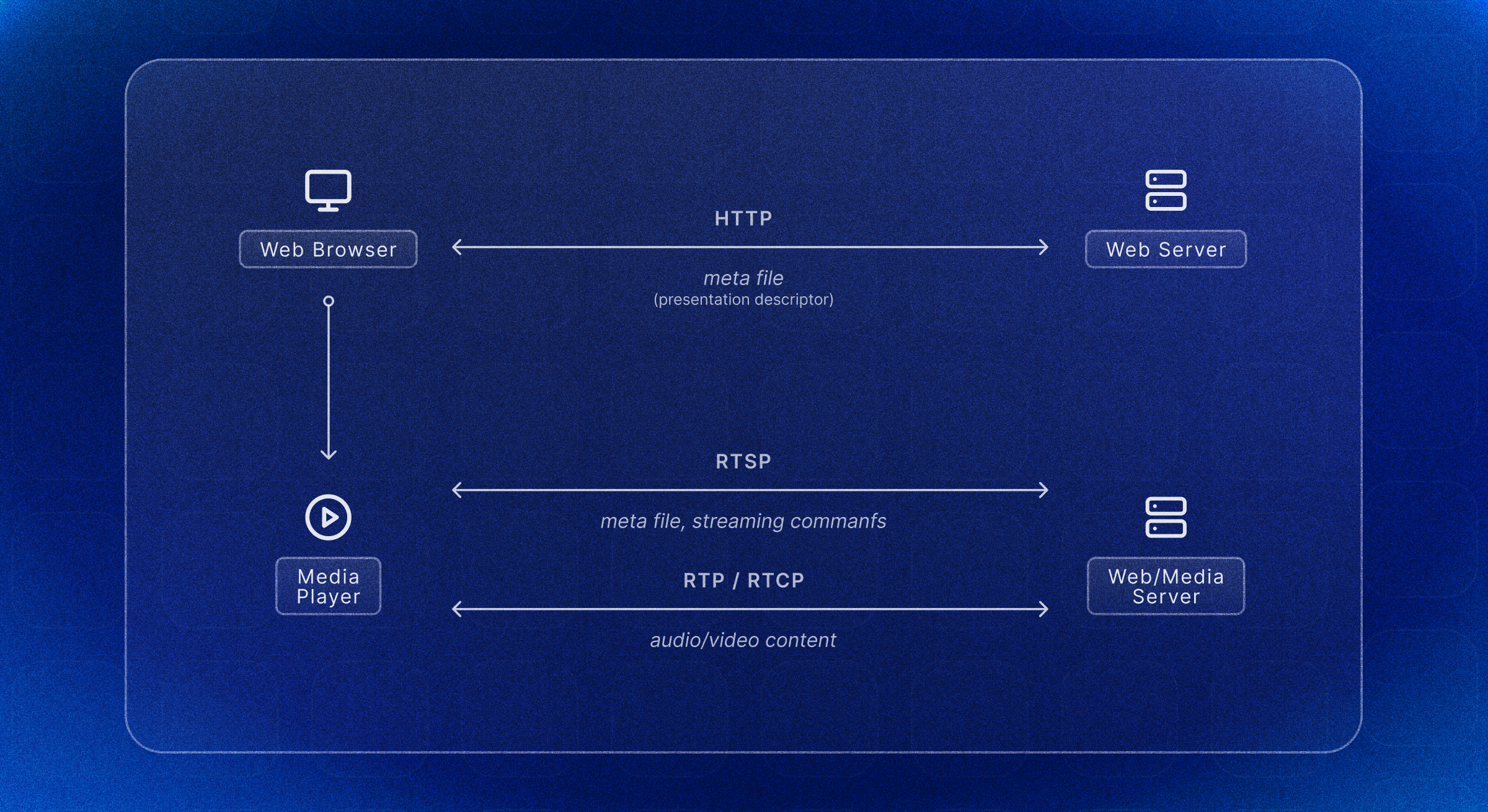Home
/ Blog /
RTCP Protocol - Everything You Need To KnowRTCP Protocol - Everything You Need To Know
November 13, 20234 min read
Share
Definition
The Real-Time Transport Control Protocol (RTCP) is a network protocol that works in conjunction with the Real-Time Transport Protocol (RTP) to provide out-of-band control information for the delivery of multimedia content over IP networks. It is primarily used in multimedia streaming systems to provide feedback on the quality of service, allowing for adaptive behavior based on network conditions.
What does it really mean?
Imagine you're watching a soccer match. The players on the field (representing RTP, the protocol that sends media data) are running around, passing the ball, and trying to score goals. The coach on the sideline (representing RTCP) observes the players, understands how the game is going, and provides guidance.
If a player is out of position, the coach gives feedback. If the team's strategy isn't working, the coach can change tactics. The coach doesn't play directly, but his feedback and guidance are crucial for the team to perform at its best. Similarly, RTCP provides feedback about the "game" of media streaming, helping to improve the quality of the experience.
History of RTCP
What was used before RTCP?
Before the widespread adoption of RTCP and its companion RTP, multimedia communication over networks was somewhat fragmented. There wasn't a standardized protocol designed specifically for real-time multimedia data transport over IP networks. Some early solutions included:
- Proprietary protocols: Before standardization, many companies developed their own protocols for multimedia streaming, leading to interoperability issues.
- Basic UDP/TCP: For early multimedia applications, simple transport using UDP (User Datagram Protocol) or TCP (Transmission Control Protocol) was common. However, these lacked features specifically tailored for real-time media streaming.
What challenges did it face?
The primary challenges faced by these early solutions were:
- Lack of Quality of Service (QoS) Feedback: Without a feedback mechanism, it was challenging to adjust to changing network conditions, which could degrade the multimedia experience.
- Interoperability: With a plethora of proprietary solutions, it became difficult for different systems to communicate seamlessly with one another.
- Synchronization Issues: Handling multimedia streams, especially in a conferencing scenario where audio and video need to be in sync, was difficult without a standardized protocol.
- No dedicated mechanism for media-specific tasks: Basic transport protocols like UDP and TCP weren't designed with real-time media considerations like timing and order preservation, leading to potential quality degradation.
How RTCP is solving it?
RTCP, in conjunction with RTP, addressed these challenges in the following ways:
- Feedback Mechanism: RTCP provides feedback on the quality of the multimedia transmission, allowing adaptive behavior based on network conditions. It offers metrics on packet loss, jitter, and round-trip delay, enabling corrective actions.
- Standardization: The introduction of RTP and RTCP as standardized protocols by the IETF in RFC 3550 meant a unified approach to multimedia streaming over IP. This eased interoperability issues.
- Synchronization: With RTP's timestamping mechanism and RTCP's reporting, it became easier to achieve synchronization between audio and video streams, enhancing the quality of experience.
- Tailored for Multimedia: RTP was specifically designed for real-time multimedia data transport, and RTCP complemented it by offering control and feedback capabilities.
RTCP
Functionality and Benefits
In the landscape of real-time media over IP networks, while RTP shoulders the responsibility of payload delivery, RTCP is indispensable for its control and monitoring functionalities. Its significance lies not just in being a companion to RTP but in the rich set of feedback it provides.
RTCP's primary objective is to convey statistical and control data consistently. By periodically sending compound packets, it offers a snapshot of the current media session's health. These packets can include:
- Sender Report (SR): Contains transmission statistics from the perspective of the sender.
- Receiver Report (RR): Relays reception statistics as viewed by the receivers.
- Source Description (SDES): Offers metadata about the participants in a session.
- Bye: Signifies the end of participation in a session.
The adaptability and efficacy of modern VoIP systems, teleconferencing tools, and live-streaming platforms can be attributed significantly to the symbiotic relationship between RTP and RTCP. When building or optimizing such systems, a deep understanding of RTCP's mechanisms and its interaction with RTP is paramount to ensure a robust and high-quality real-time media experience.

A typical setup for streaming media where the initial setup is done via HTTP/RTSP, and the continuous media stream is handled by RTP/RTCP.
Frequently Asked Questions
What is the difference between RTP and RTCP?
RTP (Real-time Transport Protocol) is used for delivering audio and video over IP networks, focusing on stream delivery. RTCP (Real-time Transport Control Protocol) complements RTP by providing feedback on the quality of the data distribution, such as packet loss and jitter, to enable adaptive streaming.
What is the difference between WebRTC and RTCP?
WebRTC is a comprehensive technology for real-time communication in web browsers, supporting audio, video, and data exchange. RTCP, on the other hand, is a control protocol specifically used for monitoring and controlling the transmission quality in RTP-based streaming.
Does RTCP use TCP or UDP?
RTCP typically uses UDP (User Datagram Protocol) for its transport, prioritizing low latency over reliability. However, it can be configured to use TCP in environments where UDP is restricted or unsuitable.
References
- https://en.wikipedia.org/wiki/RTP_Control_Protocol
- https://www.geeksforgeeks.org/real-time-transport-control-protocol-rtcp/
- https://developer.mozilla.org/en-US/docs/Glossary/RTCP
- https://datatracker.ietf.org/doc/html/rfc3550
Glossary
Related articles
See all articles